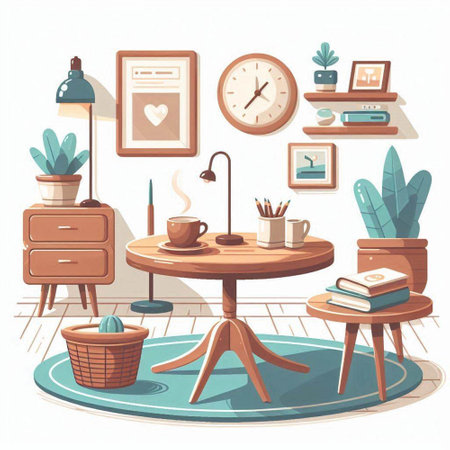Understanding Period Properties and Their Unique Appeal
When it comes to setting up a work-from-home nook in the UK, period properties offer a distinctive charm that modern builds often lack. Homes from the Georgian, Victorian, or Edwardian eras come with unique architectural features—such as elegant sash windows, ornate fireplaces, and soaring high ceilings—that immediately set them apart. These elements are at the heart of their enduring appeal, providing both character and a strong sense of history within everyday living spaces.
However, these same features that make period homes so attractive can also present practical challenges when carving out a workspace. Sash windows, for example, flood rooms with natural light but may be draughty or limit where you can place furniture. Original fireplaces act as stunning focal points but can take up valuable wall space needed for desks or shelving. High ceilings create a grand atmosphere yet sometimes make heating less efficient and acoustics more challenging. Understanding how these characteristics impact your choices is the first step towards creating a home office nook that balances productivity with period authenticity.
Choosing the Ideal Location for Your Home Office Nook
Selecting the best spot for a work-from-home nook in a period property demands more than just finding an empty corner. Traditional British homes—whether Victorian terraces, Edwardian semis, or Georgian townhouses—often have unique layouts and charming architectural details. To create a workspace that is both practical and respectful of your home’s heritage, it’s essential to balance functionality with preservation.
Key Considerations for Selecting Your Workspace
Begin by assessing natural light. In the UK, daylight can be limited, especially during the winter months. Position your desk near sash or bay windows if possible, as these often provide ample light in older homes. However, be mindful of direct glare on your screen. Next, consider foot traffic: avoid high-traffic areas like hallways or near the kitchen to minimise distractions and maintain productivity.
Preserving Period Features
One of the joys of working from a period property is the abundance of character features such as original fireplaces, cornicing, and wooden floors. When planning your office nook, aim to highlight rather than obscure these elements. For example, use alcoves or underused corners beside chimney breasts for compact desks and shelving—this not only saves space but also keeps period detailing visible.
Location Assessment Table
| Factor | Consideration | Recommendation |
|---|---|---|
| Natural Light | Amount and direction of sunlight | Choose rooms with east/south-facing windows; avoid deep north-facing rooms if possible |
| Foot Traffic | Noisy areas vs. quiet spaces | Select rooms away from main thoroughfares like kitchens or front doors |
| Period Features | Original architectural details | Work around fireplaces, alcoves; avoid covering decorative mouldings or skirting boards |
Ultimately, creating an effective home office nook in a period property is about respecting the past while meeting present needs. By carefully considering location, light, and layout, you can carve out a workspace that feels both modern and quintessentially British.

3. Blending Modern Office Requirements with Historic Interiors
Transforming a period property into an efficient work-from-home space is as much about sensitivity as it is about functionality. The challenge lies in integrating the digital necessities of the modern world—think reliable broadband, ample plug sockets, and ergonomic seating—without compromising the characterful features that make historic homes unique.
Broadband Without the Eyesore
Start with connectivity. Period homes often have thick walls or quirky layouts, which can impede Wi-Fi signals. Consider investing in mesh Wi-Fi systems for consistent coverage without intrusive cabling. Where possible, route cables discreetly along skirting boards or through existing service voids. If you must drill, choose spots already obscured by furniture or architectural details to minimise visual disruption.
Plug Sockets: Modern Needs, Subtle Solutions
The typical Georgian or Victorian home wasn’t designed with multiple devices in mind. Instead of unsightly extension leads snaking across antique floorboards, opt for stylish floor boxes or retrofit plug sockets into existing recesses. There are now classic-look faceplates available in brass or porcelain that blend seamlessly with period decor while providing the functionality needed for today’s tech-heavy lifestyles.
Ergonomics Meets Aesthetics
Ergonomic furniture doesn’t have to look out of place. Seek out desks and chairs that echo traditional materials—like oak, walnut, or painted wood—but deliver on comfort and adjustability. A well-chosen desk lamp in a heritage finish can complement sash windows or ornate cornicing while illuminating your workspace efficiently. Whenever possible, avoid fixing anything permanently to original walls; instead, use freestanding shelves and accessories to protect plasterwork and panelling.
Ultimately, the key is thoughtful integration: select solutions that both respect the integrity of your period home and support your daily productivity. With some creative problem-solving and a nod to craftsmanship, your home office nook can be both beautifully timeless and brilliantly functional.
4. Maximising Comfort Without Compromising Character
When creating a work-from-home nook in period properties across the UK, achieving comfort while preserving your home’s historic charm is both an art and a science. Many period homes feature ornate mouldings, decorative cornices, and original timber or stone flooring—these elements are often irreplaceable and define the property’s unique character. Yet, older homes also present distinct challenges in climate control, lighting, and soundproofing. Here’s how to strike the right balance.
Climate Control for Heritage Spaces
Modern climate solutions must be sympathetic to period features. Traditional radiators can often be retained or upgraded with thermostatic valves for precise temperature control without detracting from the décor. Avoid drilling into mouldings or skirting boards for new heating installations. Instead, consider discreet secondary glazing to improve insulation while maintaining original sash windows’ appearance.
| Solution | Period Feature Consideration |
|---|---|
| Thermostatic radiator valves | No alteration to cornices or skirting |
| Secondary glazing | Keeps sash window frames intact |
| Draught excluders (door/window) | Non-invasive; protects floors and architraves |
Lighting: Blending Old and New
Natural light is a prized asset in many period homes thanks to large windows and high ceilings. However, artificial lighting must be chosen carefully. Use floor lamps or clip-on picture lights that do not require wiring through original plasterwork or coving. Where task lighting is needed, select portable desk lamps or LED strips mounted using removable adhesive pads, thus avoiding permanent marks on wood panels or decorative plaster.
Recommended Lighting Approaches:
- Freestanding lamps: No impact on existing cornices or ceiling roses
- Clip-on/picture lights: Highlight architectural details without drilling
- Portable LED strips: Flexible placement; no damage to finishes
Soundproofing with Sensitivity
Period homes often suffer from thin walls and echoing spaces due to high ceilings and hard flooring. For acoustic comfort, prioritise reversible interventions. Thick rugs or runners protect original floors while dampening noise; heavy curtains absorb sound without altering window surrounds. Bookcases filled with books can double as stylish sound barriers against party walls—preserving both aesthetic and peace of mind.
| Soundproofing Method | Sensitivity to Period Details |
|---|---|
| Thick area rugs/runners | No adhesives; preserves floorboards/tiles |
| Heavy curtains (thermal/velvet) | No impact on window frames/mouldings if using tension rods |
| Bookcases along walls | Adds mass without structural changes; complements interiors |
A Note on Preservation Ethics:
If you’re unsure about any intervention, always consult with conservation officers or heritage professionals—especially if your property is listed. Many reversible solutions exist that allow you to enjoy modern comforts without making permanent alterations.
5. Personalising Your Work-from-Home Space
One of the joys of creating a work-from-home nook in a period property is the opportunity to imbue your workspace with unmistakable British character. Rather than opting for generic office furniture, consider incorporating vintage finds—think an old oak writing desk or a mid-century lamp picked up from a local antiques fair. These pieces not only bring individuality and charm but also resonate beautifully with the architectural heritage of UK period homes.
Muted palettes work wonders in such settings. Soft greys, sage greens, and gentle creams echo the understated elegance commonly found in Georgian, Victorian, or Edwardian interiors. Layering these tones can help maintain a calm, focused atmosphere while allowing original features like cornicing or sash windows to shine.
To further enhance your nook’s sense of place, hang art by local artists or display framed prints of classic British landscapes. This could be anything from watercolours of the Cotswolds to contemporary pieces from your nearest art market. If space allows, mix in tactile elements such as woollen throws or tweed cushions—details that nod to Britain’s rich textile history and provide comfort during long working hours.
The key is balance: blend practical needs with personal touches that celebrate both your own taste and the unique spirit of your period home. This approach ensures your workspace remains functional yet brimming with character—a true reflection of both you and your property’s story.
6. Practical Considerations: Permissions, Maintenance, and Keeping it Green
Adapting period properties for home working is not just a matter of taste; it requires careful attention to practicalities, particularly when dealing with listed buildings and heritage features.
Securing Listed Building Consent
If your property is listed, any alteration—even minor changes like installing built-in desks or new electrical points—may require listed building consent from your local planning authority. It’s crucial to consult with your council’s conservation officer before starting any work. Failure to obtain the necessary permissions can lead to legal headaches and may even require you to reverse unauthorised changes. Always err on the side of caution and keep documentation for future reference.
Regular Upkeep and Preventative Maintenance
Period homes come with quirks that newer builds simply don’t have. When setting up a work-from-home nook, be mindful of ongoing maintenance needs—think damp, draughts, or ageing timber frames. Incorporate regular inspections into your routine, especially around newly adapted spaces. Opt for reversible fixtures and fittings where possible, which not only preserve original features but also make future repairs less invasive.
Sustainable Choices for Modern Living
The UK’s drive towards greener living means sustainability should be central in your decisions. Choose eco-friendly paints, reclaimed materials, and energy-efficient lighting that complement the character of your home without compromising on environmental responsibility. Even small steps—such as draught-proofing windows or using low-energy heaters—can make a significant difference in both comfort and carbon footprint.
A Balanced Approach
Ultimately, creating a productive home office in a period property is about balancing respect for history with the demands of modern life. Thoughtful planning ensures that your workspace is both functional and sympathetic to its unique surroundings—making your workday more inspiring, while protecting the heritage value for generations to come.


